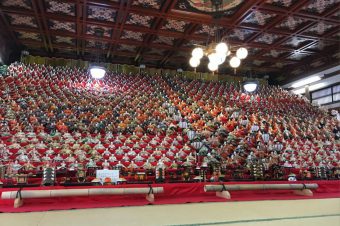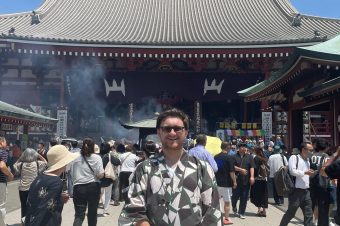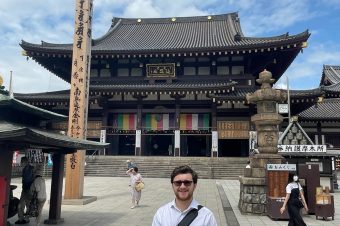The word of festival in Japanese is “Matsuri”. The purpose of having traditional events and local events is to create community revitalization. It looks like there are many different kinds of festivals in Japan, however, they all originally derive from entertaining a god.
Festivals are an essential part of Japanese people’s lives. This is because matsuris create extraordinary memories. Living an ordinary and boring life creates stress and exhaustion unknowingly. That’s why matsuris are very important to change our mind and keep us feeling lively. We picked out fifteen stunning festivals in Japan that you might feel are a bit weird. Enjoy our articles.
1 Namahage Sedo Festival
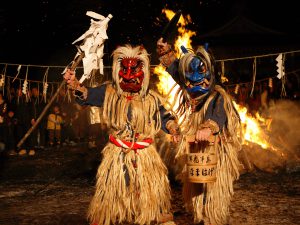 This grand winter festival is the fusion of Namahage, a folk tradition, and the Sedo Festival, a Shinto ceremony. Sacred fires light the precincts where the dynamic Namahage dance and drums are performed. Fifteen Namahage performers march down from the mountain bearing torches, bringing the night to its climax. The sticky rice cakes, which Namahage hand out, ward off disaster.
This grand winter festival is the fusion of Namahage, a folk tradition, and the Sedo Festival, a Shinto ceremony. Sacred fires light the precincts where the dynamic Namahage dance and drums are performed. Fifteen Namahage performers march down from the mountain bearing torches, bringing the night to its climax. The sticky rice cakes, which Namahage hand out, ward off disaster.
This event is held at Shinzan Shrine, located on Mt. Shinzan in Akita Prefecture, and is surrounded by majestic cedar trees. It is one of the most historical and the most revered shrines on the Oga Peninsula, deeply associated with the famous folk tradition Namahage. This festival is held every February across the precincts.The festival is based upon the old Namahage tradition, which is held every year on New Year’s Eve throughout 80 villages in city of Oga of the Akita prefecture. On New Year’s Eve, young men from the various villages dress as Namahage and go from house to house shouting loudly “Are there any crybabies here?” To the people of Oga, the Namahage are visiting gods that come with the New Year to warn against laziness, and bring protection from illness and disasters, a good harvest, and plenty of food from the mountains and sea. In 1978, Oga’s Namahage were designated officially as an Important Intangible Cultural Asset in Japan.
To see more, here is a video about this festival.
Date: 12th~14th February 2017
Address: 97 Kitaurashizan, City of Oga, Akita prefecture
Access: You can take a Shutle Bus from “Akita Station” *extensional fees*
Akita prefecture is located next to Aomori prefecture ( It is close to the city of Sapporo.) It is part of the “Tohoku area” of Japan. Therefore, you can access easily by Shinkansen or car.
2 Soumanoumaoi Fesitival
-Wild Samurai Riding on Horses: A Festival in Soma City, Fukushima
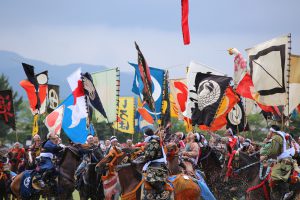 Have you ever heard about the Soma-Nomaoi Festival? It is a famous horse race festival in Fukushima Prefecture. The festival is organized by three important shrines in Fukushima Prefecture: Ota Shrine, Odaka Shrine (Minami-Soda City) and Nakamura Shrine (Soma City).
Have you ever heard about the Soma-Nomaoi Festival? It is a famous horse race festival in Fukushima Prefecture. The festival is organized by three important shrines in Fukushima Prefecture: Ota Shrine, Odaka Shrine (Minami-Soda City) and Nakamura Shrine (Soma City).
The festival’s origin lays in the training of horses for military reasons. Today, the festival is celebrated as a cultural highlight and sightseeing event in the Kyushu area. The festival has a history of more than 1000 years and today it remembers the society of the Warring States Period of fighting warlords.
The festival is held for three days, and men transform into Samurais with beautiful costumes. They ride on horses with different flags, which remember their city, over a distance of 1000 meters. This tradition first started as a military exercise by Taira no Kojiro Masakado, the founder of the Soma Clan. The idea was to train horses as a new military tool. It was possible for this tradition to survive because of the long and continuous rule of the Soma clan from the Kamakura Period through the end of the Edo Period.
To learn more, here is a video about this festival
Dates: Every year, End of September (Sunday~Monday)
Address: city of Soma, Fukushima prefecture
Access: Express Bus from “Sendai Station” or “Fukushima Station (West Exit)”
Fukushima Prefecture is located in the Tohoku area. You can access easily from Tokyo by using Shinkansen or by renting a car. Further, you can use an express bus. Express busses are cheaper than using the Shinkansen.
3 Tobata Gion Festival
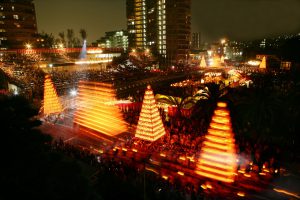 Once a year, people can be seen walking through the town of Tobata shouldering giant 10-meter floats with 12 tiers of lanterns. These people wear traditional cloth (happi) and headbands (hachimaki) and to keep their steps in unison, they shout-out, ”Yoitosa!-Yoitosa!” This event is called the Tobata Gion Yamagasa Festival.
Once a year, people can be seen walking through the town of Tobata shouldering giant 10-meter floats with 12 tiers of lanterns. These people wear traditional cloth (happi) and headbands (hachimaki) and to keep their steps in unison, they shout-out, ”Yoitosa!-Yoitosa!” This event is called the Tobata Gion Yamagasa Festival.
This festival originated from the Tobata Ward in Kitakyushu, Fukuoka prefecture, back in 1802. At the time, the village people were plagued by an epidemic, and they would continuously pray to the Gods for the epidemic to cease. Then, one by one, those who were suffering from the plague recovered. The village people believed it was because of the praying, so they built the Yamagasa and celebrated in 1803.
Decorations of the Yamagasa date back to 1829 and their curtains tell of the history and tradition. The Tobata Gion Yamagasa festival consists of three days of shrine festivities, which are held at the Tobata Hachimangu Shrine, the Sugawara Jinja Shrine and Nakabaru Hachimangu Shrine.
There are giant floats with 12 traditional decorated frags that are carried through the town during the day. In the evening, the decoration style changes, and a unique type of float parades through. Each of these floats is called the “Pyramid of Light” because of the 309 paper lanterns that hang in their 12 tiers. Each float is 10 meters tall and weighs 2.5 tons, so it needs about 80 float-carriers to shoulder it. At the end of the festival, there are 4 giant floats and 4 small floats that gather to compete at a competition called the Kyoenkai. Spectators watch in awe of the magnificence and bravado of the show.
To learn more, here is a video about this festival.
Date:22th~24th July
Address: Tobata, City of Kitakyushu, Fukuoka prefecture
Access: The JR Tobata station(Walk:5 mins)
It is closed to city of Fukuoka and it takes just 23 mins by Shinkansen.
4 Awa Odori Fesitval
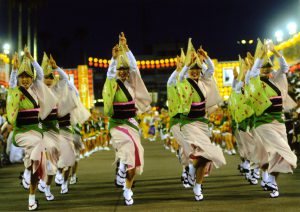 If you are interested in attending festivals within Japan, there is none better than the Awa Odori. The Awa Odori is a festival held in Tokushima but is known all across Japan, as well as many parts of the world. This festival rivals the Rio Carnivale as one of the largest dance events in the world.
If you are interested in attending festivals within Japan, there is none better than the Awa Odori. The Awa Odori is a festival held in Tokushima but is known all across Japan, as well as many parts of the world. This festival rivals the Rio Carnivale as one of the largest dance events in the world.
The Awa Odori, translated as the Awa Dance, has a history of over 400 years. The troupes that perform for the festival are often invited to foreign countries to perform because their talent is so highly revered.
The festival sprawls over a period of four days, typically August 12-15, and takes place in several different locations across the prefecture. The most popular event is held in Tokushima City and draws nearly 1.3 million guests every year. The event runs from 6 P.M. to 10:30 P.M. and transforms the entire landscape of the city into a giant stage for the performers.
Watching these performances across plazas, parks, streets and sidewalks, this is definitely a unique and incredible experience you won’t want to miss.
To learn more, here is a video about the festival.
Date:12th~15th August
Address: City of Tokushima, Tokushima prefecture.
Access:“The JR Tokushima Station”(Wal: 10 mins)
The Tokushima prefecture is part of the Shikoku island. It is easy to go there from Kyoto, Osaka or Kobe. You can fly by airplane,using Shinkansen or car.
5 Aomori Nebuta festival
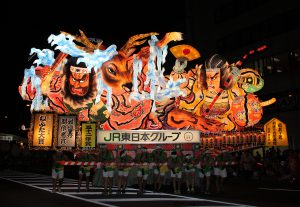 The Aomori Nebuta festival is held on the 2nd of August to the 7th every year. There are about 20 floats carrying huge dolls and almost 300 million visitors come to see it. This festival was designated as a “significant intangible folk cultural asset” in 1980 and is one of the most famous festivals in Japan.
The Aomori Nebuta festival is held on the 2nd of August to the 7th every year. There are about 20 floats carrying huge dolls and almost 300 million visitors come to see it. This festival was designated as a “significant intangible folk cultural asset” in 1980 and is one of the most famous festivals in Japan.
All the “nebuta ” have been made by professionals. They cover them in art based upon historical stories. They use wires to make frames and use about 2500 Japanese papers. The floats (about 2 meters height) are topped with huge dolls, each about 5 meters height, 9 meters wide, 7 meters long, and 4 tons in weight. They are absolutely huge.
There are a lot of theories about the origin of this festival. We’ll introduce one of them. During the Nara period (710~794), the Nebuta festival was paired with the “The Star festival” from China, and a local ceremony was held, called the “Spirit Boat Procession.” This event was held in the Tsugaru area in the Aomori prefecture. Since the papers, bamboo and candles are still available today, these are used for making lanterns for today’s festivals. During the Nebuta festival, they make the lanterns in the shape of giant dolls. Because the origin of this festival comes from “The Star Festival,” they releases lanterns into the river and sea to vanish uncleanness in a purification ceremony during the final day of festival in order to pray for a perfect state of health. This is called “the floating nebuta.”
Festival dancers, called “Haneto,” dance and jump while chanting “rasserah rasserah” to liven up the festival. There are approximately 90,000 haneto dancers. There are bells on the haneto yukatas, which are called the “nebuta bells,” and they are also called “the bell that brings happiness.” Whoever picks up bells that have fallen from a haneto will receive good luck. You can also receive good luck by being handed the bell from someone else. If you want to participate in the festival, you can rent the costume at shops nearby. Whoever wears formal haneto wear can participate. Please feel free to come join and make unforgettable memories.To learn more, here is a video about the festival.
Address: City of Aomori, Aomori prefecture
Date: Every year: 2nd ~ 7th August
Access: The JR Aomori station (Walk: 20 mins)
The Aomori prefecture is located in the Tohoku area of Japan next to Hokkaido. It is easily to access from Sapporo. You can also use Shinkansen.
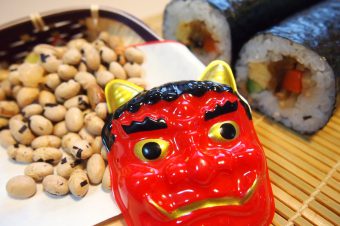
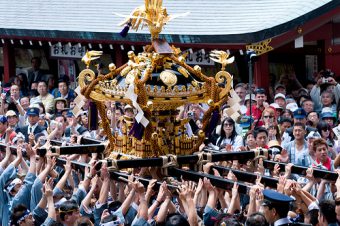
-340x226.jpg)
